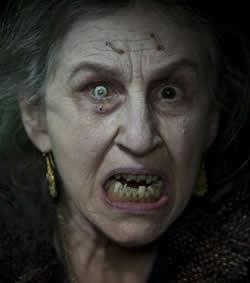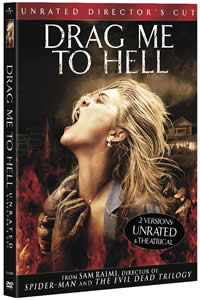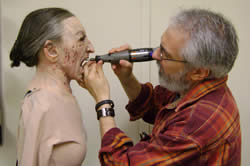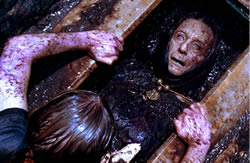 Written by Scott Essman
Written by Scott Essman
When directors hit box-office gold, it is common knowledge that they can make whatever they wish for a followup film. For Sam Raimi, coming off of three Spider-Man films which all rank in the top 50 domestic box office grossers of all time, he could have made virtually any film he could conjure as his next cinematic venture. But, what did the director of such cult classics as Within the Woods (1978), The Evil Dead (1981), Evil Dead II (1987), and Darkman (1990), decide to do after exiting the world of Spider-Man? One only need look at the opening animated Universal logo to determine Raimi’s intentions: the director chose a pre-1997 Universal opening to set the stage of this film: we were going on a journey that would be a throwback to the time when Raimi was a cult director, still largely undiscovered by the Hollywood mainstream.
For horror enthusiasts, when you think of Raimi’s early work, you recall shaky but taut camera moves, a mélange of harsh sound and light, intensified performances, and unsubtle moments of discovery and revelation. You simultaneously remember the outrageous often guttural practical makeup effects in those films: Evil Dead featured buckets of blood while the sequel was somewhat refined if still surreal in its over-the-top portrayal of horror as a genre that was being infused with new post-slasher film blood, built on the heels of the successes of the original Halloween, Dawn of the Dead, Friday the 13th, and other instrumental films in the genre.
Enter into this world a name that goes hand-in-hand with horror over the past decades that Raimi has been active in reinventing the genre. “If you’ve seen a horror movie in the last 15 years, they did it,” said special ‘horror’ makeup effects legend Tom Savini of the KNB EFX Group, a makeup effects and creature shop lead by Greg Nicotero and Howard Berger, and co-founded by ex-member Robert Kurtzman in 1988.
 With his career coming full circle, Greg Nicotero and his company were the special makeup effects, corpse and special props designers on Sam Raimi’s new retro-horror film on Universal Studios Home Entertainment DVD and Blu-ray Hi Def, Drag Me to Hell. Of course, this is because Nicotero started with Raimi 22 years ago with Evil Dead 2 in which they created numerous makeup effects and creatures. In this exclusive look into his studio, we see how the different makeups, fake bodies and props from the film were designed and realized.
With his career coming full circle, Greg Nicotero and his company were the special makeup effects, corpse and special props designers on Sam Raimi’s new retro-horror film on Universal Studios Home Entertainment DVD and Blu-ray Hi Def, Drag Me to Hell. Of course, this is because Nicotero started with Raimi 22 years ago with Evil Dead 2 in which they created numerous makeup effects and creatures. In this exclusive look into his studio, we see how the different makeups, fake bodies and props from the film were designed and realized.
Nicotero, a Pittsburgh resident, has now been working in motion pictures for 25 years, starting as a makeup assistant on George A. Romero’s 1985 Pittsburgh-based film, Day of the Dead with Tom Savini. “I knew Greg Nicotero since he was 15,” said Savini. “He used to hang out on Creepshow. I used him on Day of the Dead and [Romero’s] Monkey Shines. He asked me to go to LA and form a company before KNB. He then introduced me to Howard Berger on Day of the Dead. I’m a Pittsburgh guy, so I’m not out there knowing who the up-and-comers are.”
With certainty, the mentorship that Savini provided to Nicotero and later Berger in the 1980s paid dividends for the duo, then in their 20s, as they learned both the creative and business aspects of running a makeup effects company. “Greg was a sketch artist and would handle my paperwork and my business stuff which is what he went to school for,” Savini added. “He dropped out of medical school to work for me. He had his hands in sculpting, but he wasn’t into doing the makeup back then. He learned by experience and now he’s a major player in the makeup world. He’s my best friend.”
Since they formed the studio in 1988, moving locations but remaining in the San Fernando Valley, KNB EFX Group has gotten many choice assignments, having been responsible for dozens of movie projects, including all of the films of Quentin Tarantino, Robert Rodriguez, Wes Craven, and John Carpenter to name but a few. KNB has also joined the ranks of the A-list doing prestigious projects for the likes of Steven Spielberg, Martin Scorsese, and winning an Oscar for their work on the first Narnia film.
Thus, it was not surprising that after 22 years, Raimi, 50 this month, contacted KNB to handle the numerous gruesome effects that Drag Me to Hell required, harkening back to the director’s pre-Spider-Man days with the Evil Dead trilogy. Naturally, Nicotero speaks fondly of KNB’s working relationship with Sam Raimi for the past 20 years. “It has been pretty amazing,” said the effects master, 46. “We started with Sam and [producer] Rob Tapert on Evil Dead 2 and once KNB was formed in 1988, we handled most of the makeup and suit effects for their films for well over the next decade with everything from Army of Darkness to [TV’s] Hercules and Xena, A Simple Plan and so on. We didn’t get the chance to work on the first two Spider-Man films, but Sam personally pulled us in on part 3, and I was delighted.”
 Initially, Nicotero was concerned that KNB would not be involved in the designs for makeups, gags, props, and other work as it might have likely been handled by another conceptual artist, a common practice in contemporary filmmaking. “Sam is very accustomed to working with outside designs,” Nicotero explained, “so I, during my first meeting, showed him samples of the design work we did in-house and he really responded to what I had shown him. In this day and age, with so many conceptual artists that have background in creature effects, productions very often bring in the effects houses late in the game as opposed to having the supervisors having a hand in the conceptualizing and design.”
Initially, Nicotero was concerned that KNB would not be involved in the designs for makeups, gags, props, and other work as it might have likely been handled by another conceptual artist, a common practice in contemporary filmmaking. “Sam is very accustomed to working with outside designs,” Nicotero explained, “so I, during my first meeting, showed him samples of the design work we did in-house and he really responded to what I had shown him. In this day and age, with so many conceptual artists that have background in creature effects, productions very often bring in the effects houses late in the game as opposed to having the supervisors having a hand in the conceptualizing and design.”
Raimi, however, is no stranger to working with effects teams and knew of KNB’s vast experience and hands-on approach, so getting KNB involved from the beginning was, according to Nicotero, “what the director wanted on this film; and he very much wanted input on what fans and audiences would respond to. Certainly our history made him very comfortable. I presented designs to him that were fleshed out here [at KNB], and we went from there. Shannon Shea was my right hand man on the show, and between John Wheaton, Garrett Immel, and Norman Cabrera, we brought some really fun ideas to the table.”
In Drag Me to Hell’s story, Alison Lohman plays the young Christine Brown, an ambitious bank clerk who is encouraged to be more aggressive by her competitive boss, played by David Paymer. Wanting a promotion, she denies a house loan extension to a mysterious Gypsy customer, Mrs. Ganush, perfectly played by Lorna Raver. For the character, KNB had to devise a shockingly grotesque haggard makeup for Raver, and they proceeded to create several versions of Raver’s character through the film. “We had worked out several stages via tests and Photoshop,” Nicotero said, “and of course her dentures played a significant part. Mainly, she goes from sympathetic old woman to ‘heinous horror hag’ in the car sequence, to back-from-the-dead possessed Ganush, as well as her demonic form. All [stages] had a variety of 3D transfers, prosthetics, contacts – Professional Vision Care always handles our work and has done so for years, supervised by Christina Ceret – and dentures. Garrett Immel, Camille Calvet Della-Santina and Mary Kay Witt applied her make-up. We also handled a stunt likeness makeup that Garrett sculpted that was fantastic, complete with lace wig and lenses.”
After denying and “shaming” Mrs. Ganush in the bank, Christine must thwart a physical attack in her car, after which Mrs. Ganush places a horrible curse on Christine. Subsequently, when evil forces pursue Christine, she tries to make amends with Mrs. Ganush by visiting her. Alas, it is too late, as Mrs. Ganush has died, which Christine discovers in a wake scene. For this appearance of the character, KNB had to create a realistic corpse in the likeness of Lorna Raver. “For the wake sequence, we created a dummy that had a jointed armature and a silicone skin, pretty straightforward,” said Nicotero. “All of the likeness were cast off of Lorna Raver, who couldn’t have been a better sport. So often, people don’t realize that our characters are brought to life by great performances, and she was terrific. When I saw her on set the first time, I believed she was this sad, tormented old woman having her house taken away. Then, Sam would yell cut!”
Another great moment in the wake scene is when Mrs. Ganush’s dead body falls onto Christine, leading to a nauseating effect where bodily fluid comes out of the corpse’s mouth onto Alison Lohman. Undoubtedly, one of the convincing aspects of Mrs. Ganush’s character in these scenes is her false teeth. “The script was very specific in terms of the action of all the dentures,” Nicotero said. “She pulls them out, leaves them on the table [in the bank], has them smashed during the car fight sequence, and then has to put the broken teeth back in, all of which required specialized teeth that fit her and then fit over ‘gum dentures’ that we made. Grady Holder has handled our denture work for the last 10 years and is fantastic at creating all of our eyes and dental work.”
When it has become clear that Christine is truly doomed, she falls apart in a later scene in the bank when she bleeds profusely from her nose, squirting blood all over her desk and onto Paymer. “That was one of the first gags we worked out,” Nicotero stated. “It was realized with a pretty straightforward pressure pump rig with tubing that was attached to a prosthetic that glued inside the nose. The plan always was to digitally erase the tube and let the blood spray be done practically, and that was what ended up in the movie.”
In keeping with that fusion of practical techniques, such as the ones in which KNB specializes, and digital effects, Nicotero notes that Raimi entrusted much of the on-set work to KNB due to his love of the craft, even though there was some degree of collaboration involved with the computer-generated imagery team. “Sam has become quite proficient with digital effects,” Nicotero said, “and [visual effects supervisor] Bruce Jones had a lot to handle in terms of the shadow gags, visual effects of hell opening up and so forth, so there were very few instances when he augmented effects we had done practically. Truthfully, that was what was so much fun: as savvy as Sam is with effects, he still loves puppet heads and traditional prosthetic and makeup effects. During the development of the dream sequence, where rotted Ganush vomits worms on Christine, he actually laughed out loud when we showed him the first test, and told me I should be arrested.”
 Other KNB work in Drag Me to Hell includes a demonic makeup designed and created for Adriana Barraza in a séance scene where her character Shaun San Dena tries to expunge the demon who has been haunting Christine. This makeup included prosthetics and haunting contact lenses by Professional Vision Care. One of the final great KNB moments returns when Christine digs up Mrs. Ganush’s corpse in the midst of a downpour in an attempt to reverse the curse, which involves a reappearance of the dead Ganush body, which was created to withstand drenching.
Other KNB work in Drag Me to Hell includes a demonic makeup designed and created for Adriana Barraza in a séance scene where her character Shaun San Dena tries to expunge the demon who has been haunting Christine. This makeup included prosthetics and haunting contact lenses by Professional Vision Care. One of the final great KNB moments returns when Christine digs up Mrs. Ganush’s corpse in the midst of a downpour in an attempt to reverse the curse, which involves a reappearance of the dead Ganush body, which was created to withstand drenching.
When reflecting on the special makeup effects in Drag Me to Hell and his work with Raimi, who co-wrote the script with brother Ivan Raimi, Nicotero exudes earned pride, now over two decades into the artist-director relationship. “I am tremendously proud of what KNB contributed,” he said. “An amazing team of artists, mechanics, puppeteers and makeup artists really helped Sam bring into the movie the fun that he has making these films. During script read-throughs, he would be reading something and then start chuckling to himself because some of the elements are so outrageous. The movie is pure fun, and Sam’s enthusiasm is there in every frame.
Artist and author Kevin James Breaux is about to be snatched up by Dark Quest Books for his Fantasy novel Soul Born, making it his first published novel. Before he becomes famous and it all goes to his head, let's interview him about his horror, his fantasy, and his art. He writes short stories and novels about zombies, vampires, and fairies with equal ease, and his artwork can be seen in Zombie CSU: The Forensic Science of the Living Dead and They Bite!
